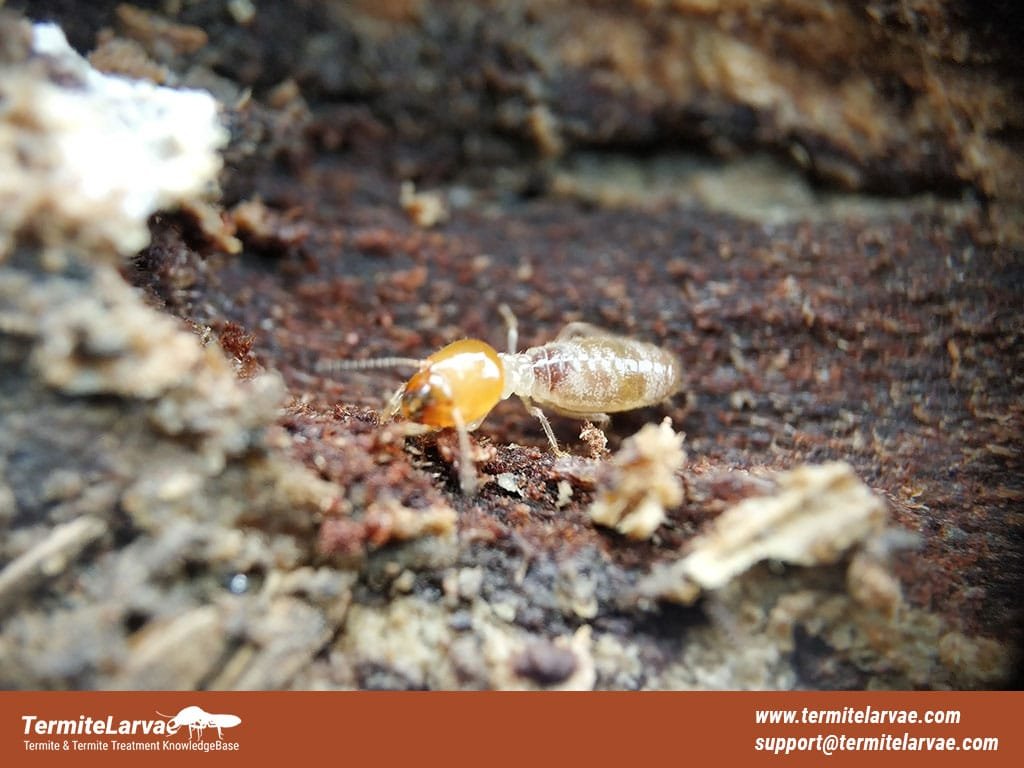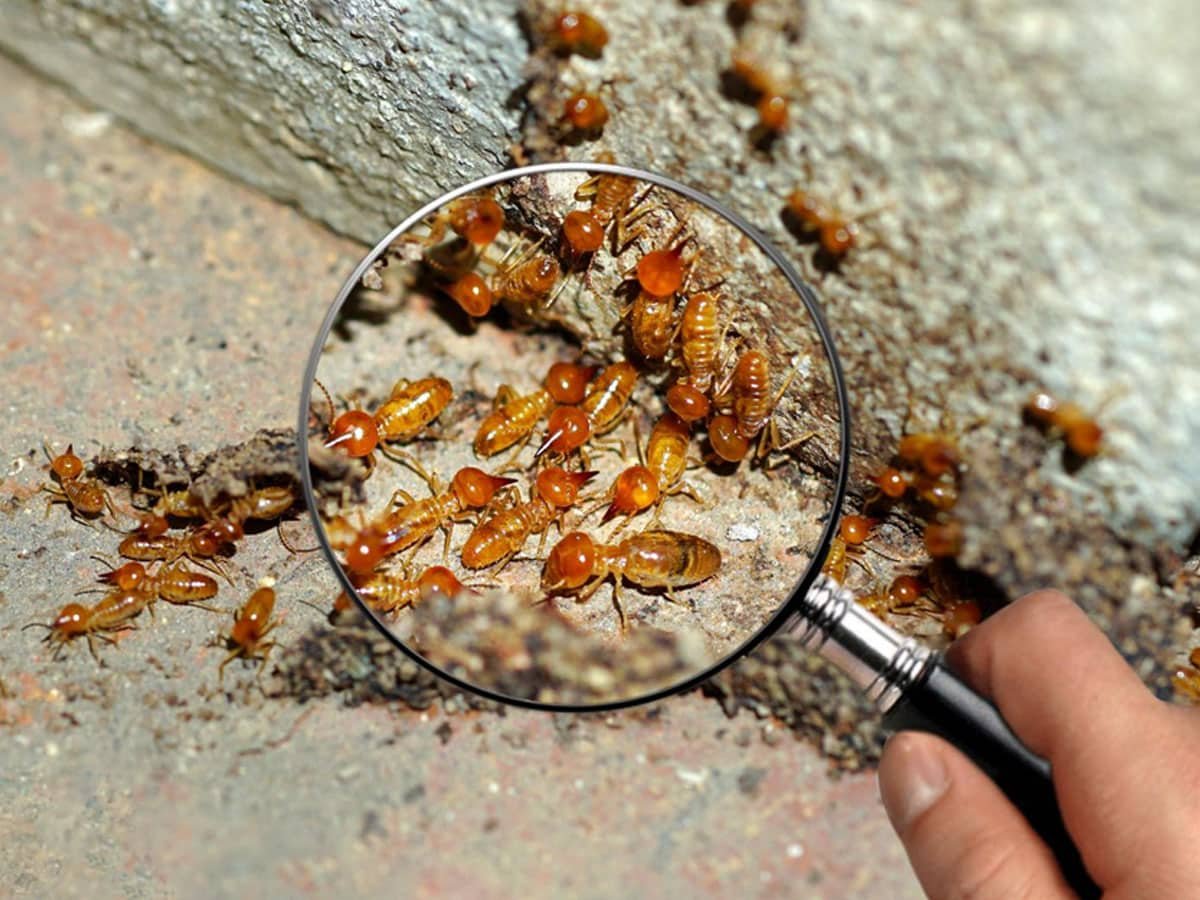Drywood termites, scientifically known as Kalotermitidae, are a species of termites that pose significant threats to wooden structures. Unlike other termite species, they do not require contact with soil and can thrive in dry wood, making them particularly challenging to detect and control.
These termites are typically larger than other species, with a size range of about 3/8 to 1 inch. They are often characterized by their hard, segmented bodies, which range in color from light to dark brown. The unique aspect of Drywood termites is their ability to extract moisture from the wood they consume, allowing them to inhabit even the driest of woods.
Types of Drywood Termites: Desert, Southeastern, Western
There are several types of Drywood termites, but the most notable are the Desert, Southeastern, and Western species.
- Desert Drywood Termites (Marginitermes hubbardi): Primarily found in desert climates, these termites are known for their resilience in extremely dry conditions. They are smaller in size and typically lighter in color compared to other species.
- Southeastern Drywood Termites (Incisitermes snyderi): Common in the southeastern regions of the United States, these termites are recognized by their distinct reddish-brown color. They often infest attic spaces and can cause significant damage over time.
- Western Drywood Termites (Incisitermes minor): Predominantly found in the western states, this species is known for causing extensive damage to homes and furniture. They are often identified by their swarmers, which have a characteristic smoky black color.
Each type of Drywood termite has its unique habitat preferences and physical characteristics, making it crucial for homeowners and pest control professionals to accurately identify them for effective treatment.
Understanding Termite Biology and Behavior
Drywood termites are distinguished by specific physical characteristics that aid in their identification. Adult termites are typically up to 1 inch long and exhibit a range of colors from cream to dark brown, depending on their role within the colony. Notably, their bodies are segmented, and they possess six legs.
A key distinguishing feature of Drywood termites is their well-developed wings, found in reproductive members of the colony, which are almost equal in size and significantly longer than their bodies.
The Caste System: Soldiers, Alates, and Workers
The social structure of Drywood termites is complex, consisting of distinct castes, each with specific roles:
- Soldiers: Tasked with defending the colony, they are recognizable by their larger mandibles and head. They rely on the worker termites for nourishment.
- Alates (Swarmers): These are the winged, reproductive termites responsible for establishing new colonies. They are often the first sign of an infestation visible to homeowners.
- Workers: Making up the majority of the colony, workers are responsible for foraging, feeding other members, and maintaining the nest. They are smaller and lack the wings of the alates.
Understanding these roles is crucial for identifying infestation and targeting treatment efforts effectively.
Termite Colonies: Structure and Development
Drywood termite colonies typically start with a pair of alates who shed their wings and establish a new colony. These colonies develop slowly compared to other termite species, taking several years to reach maturity. A mature colony can consist of a few thousand individuals, which can spread across multiple wood structures.
Termite Swarmers: Role and Significance
Termite swarmers, or alates, play a crucial role in the termite life cycle. They emerge from the colony, usually in spring or fall, to mate and start new colonies. The presence of swarmers inside a house often indicates an established infestation nearby. Identifying these swarmers correctly is critical for early detection and control of Drywood termite infestations.
Detection and Signs of Infestation
Detecting Drywood termites early is critical to preventing extensive damage. Some common signs include:
- Swarmers: The appearance of winged termites or discarded wings, especially near windows and light sources, is a strong indicator of an active colony.
- Wood Damage: Drywood termites consume wood from the inside out, often leaving a thin veneer of timber or paint. Look for hollowed-out wood or blistering in wood surfaces.
- Termite Droppings (Frass): These are wood-colored, pellet-like droppings that termites eject from their tunnels.
Termite Droppings: Appearance and Implications
Drywood termite droppings, or frass, are distinct in appearance – resembling fine, gritty, wood-colored pellets. The presence of frass is often one of the first visible signs of an infestation. Regular inspection of areas like window sills and door frames for these droppings can help in early detection.
Common Habitats and Infestation Locations
Drywood termites typically infest dry, undecayed wood. Common infestation sites include:
- Attics and Roof Structures: Because these areas are less disturbed and have ample wood, they are prime targets for termites.
- Wooden Furniture and Frames: Termites can inhabit and feed on furniture, picture frames, and other wooden items.
- Door and Window Frames: These structures, if made of wood, can also harbor termite colonies.
Impact and Damage
Drywood termites can cause significant damage to wooden structures, often going unnoticed until severe harm has occurred. They consume wood for nutrients, weakening the structural integrity over time. Common damages include:
- Structural Weakness: Load-bearing beams and joists can be compromised, posing serious safety risks.
- Cosmetic Damage: Infested wood may appear blistered or warped. Paint may also bubble or peel where termites have tunneled close to the surface.
- Furniture Damage: Antique or wooden furniture can be ruined, leading to costly repairs or replacements.
Long-Term Effects of Infestation on Structure
Continuous feeding can weaken buildings, making them unsafe and leading to expensive structural repairs. Homes with termite damage often see a reduction in market value, affecting resale potential. Ongoing damage requires repeated repairs and maintenance, adding up to substantial costs over time.
Termite Management and Control Strategies
Effective management of Drywood termites starts with accurate detection. Inspection techniques include:
Regularly check for signs like frass, hollowed wood, and swarmers. Pay special attention to attics, window frames, and doorframes. For comprehensive assessment, a professional inspection is advisable. Experts use tools like moisture meters and borescopes to detect hidden infestations.
Whole-Structure vs. Localized Treatments
When it comes to treatment, options vary based on the infestation’s extent:
- Whole-Structure Treatments: These involve treating the entire structure and are typically used for widespread infestations. Methods include fumigation, where the entire building is sealed and gassed.
- Localized Treatments: For smaller or isolated infestations, localized treatments like spot treatments, wood injections, or the use of borates are effective.
Natural and Chemical Methods of Extermination
These include using beneficial nematodes, diatomaceous earth, or orange oil. While less harmful to the environment, their effectiveness can vary. Involves using termiticides, which are more effective but require careful handling due to their toxicity.
Specific Treatment Approaches
Bora-Care Application: Preparation and Process
Bora-Care is a borate-based product applied directly to wood. It’s mixed with water and sprayed onto infested areas, penetrating the wood and killing termites upon ingestion.
Drill and Fill Method: Steps and Precautions
Involves drilling holes into infested wood and injecting termiticides. It’s essential to cover all affected areas while ensuring safety precautions are followed.
Termite Bait Stations and Their Efficacy
Bait stations contain slow-acting poison that worker termites take back to the colony, gradually exterminating the entire colony. Placement and monitoring are key to their success.
Fumigation Techniques for Extensive Infestations
Fumigation is a comprehensive solution for severe infestations. The process involves sealing the structure and introducing a gas that penetrates all areas of the wood, eliminating the termites.
Prevention and Long-Term Management
Preventive measures are key in avoiding termite problems. Some effective strategies include:
- Regular Inspections: Conduct periodic inspections of your property, especially in areas prone to termite activity.
- Reduce Wood-to-Ground Contact: Ensure that wooden parts of the structure, like siding or posts, do not directly contact the soil.
- Seal Cracks and Openings: Fill in cracks in the foundation and around utility lines to prevent termites from entering.
- Proper Ventilation and Moisture Control: Reduce moisture in attics, basements, and crawl spaces, as damp conditions can attract termites.
Long-term Preventive Treatments and Measures
Applying borate solutions to wood during construction can make it resistant to termites. Regularly maintain and treat wooden structures, especially in areas prone to termite infestations. Installing and regularly checking bait stations can help detect early signs of termite activity.
Tips for Home Maintenance to Deter Termites
Simple home maintenance tips can go a long way in preventing Drywood termite infestations:
- Keep Wood Dry: Ensure that all wooden structures are kept dry and well-ventilated.
- Remove Food Sources: Clear debris, firewood, and other cellulose materials away from the home’s foundation.
- Paint or Seal Wood: Paint or seal exposed wood surfaces to reduce their vulnerability to termites.
Cost and Considerations in Termite Treatment
Larger and more widespread infestations typically require more extensive and thus more expensive treatments. Options like fumigation and whole-structure treatments are generally more costly than localized treatments.
Verdict
Regular inspections and being aware of signs like frass and swarmers can help in early identification of Drywood termite infestations. Various treatment options, ranging from natural methods to professional fumigation, are available depending on the extent of the infestation.
Implementing preventive strategies such as reducing wood-to-ground contact and ensuring proper ventilation can significantly reduce the risk of termite infestations. Understand the extent and severity of the infestation. This may require a professional inspection.
Frequently Asked Questions
How do I know if I have Drywood termites?
Look for signs like frass (termite droppings), hollow sounding wood, and swarmers (winged termites). Regular inspections can help in early detection.
Can Drywood termites spread quickly?
Compared to other termite species, Drywood termites spread relatively slowly. However, undetected, they can still cause significant damage over time.
Are DIY treatments effective against Drywood termites?
While some DIY methods can help, professional treatment is often necessary for complete eradication, especially in the case of extensive infestations.
Can natural methods effectively control Drywood termites?
Natural methods, such as orange oil, can be effective for small, localized infestations. However, professional treatments are generally more reliable for larger infestations.
What are the advantages of professional termite treatments?
Professional treatments are typically more thorough and come with expert knowledge and specialized equipment, increasing the likelihood of complete eradication.











